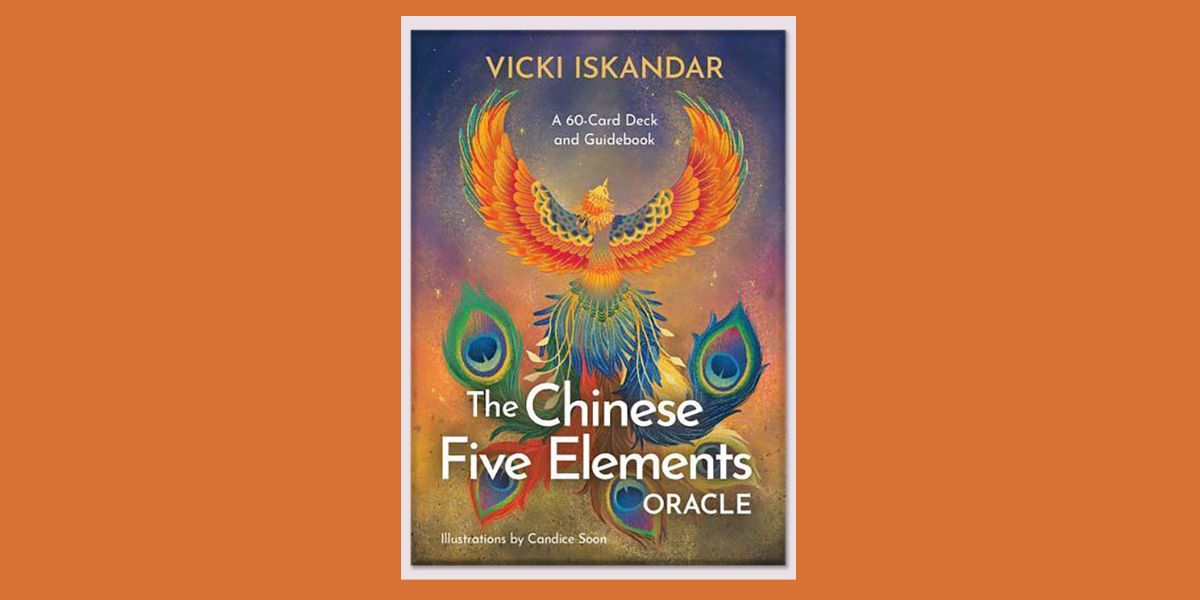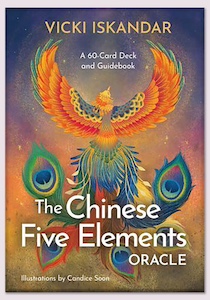
The Chinese Five Elements Oracle: A 60-Card Deck and Guidebook, by Vicki Iskandar and illustrated by Candice Soon
Hay House LLC, 140197063X, 192 pages, 60 cards, October 2023
In Taoism, the five elements of Wood, Fire, Earth, Metal, and Water are the building blocks of the universe. The elements present at birth shape our personalities and desires. Through Chinese astrology, we can attune to our own personal elemental compositions, promoting deeper self-awareness, growth, and healing.
The Chinese Five Elements Oracle combines the five elements with the twelve zodiac animals to create all sixty possible pairings. This deck was created by Indonesian-born Chinese Feng Shui consultant and astrologer Vicki Iskandar, and illustrated by Candice Soon, a self-taught artist from Singapore. It consists of sixty cards and a 185-page guidebook, representing Iskandar’s unique vision of the sixty Pillars, brought to life through Soon’s gorgeous illustrations. In her personal practice, Iskandar blends Chinese and Western astrology. Since 2012, she has shared daily astrological guidance on Twitter under the handle @5elementsoracle.
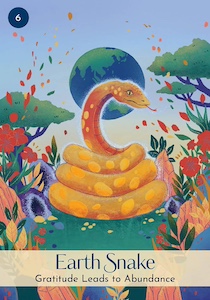
This deck is beginner-friendly, with the accompanying guidebook offering a comprehensive introduction to Chinese metaphysics, Taoism, and astrology. According to Chinese mythology, the ordering of the animal signs was established based on the outcome of a Great Race. The Rat hitched a ride on the Ox and leaped across the finish line first, winning the race and being awarded the position of first sign in the Chinese zodiac by the Jade Emperor, the Taoist ruler of the Universe.
The sixty cards, or Pillars, are divided into six cycles of ten Heavenly Stems, and the opening cycle explores the themes of Wisdom and Communication, beginning with the Wood Rat, the deck’s inaugural card and leader of the first cycle. I was born in the year of the Wood Rat, so I was thrilled to discover it was the first card in the deck when I opened the box.
Iskandar explains that the sixty cards are organized into a cyclical pattern known as the “great sexagenary cycle.”1 Each ten-card cycle begins with Yang Wood and concludes with Yin Water, while the twelve animal signs follow their traditional order: “The Rat, the Ox, the Tiger, the Rabbit, the Dragon, the Snake, the Horse, the Sheep (also called Goat or Ram), the Monkey, the Bird (or Rooster), the Dog, and the Pig (or Boar).”2
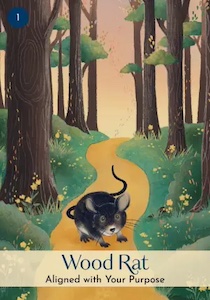
Iskandar substitutes the more familiar Rooster with the Bird, often depicted as a phoenix, due to the sign’s Yin Metal elemental energy. The Rooster, with its masculine connotations, doesn’t accurately reflect the sign’s feminine nature. Iskandar emphasizes the importance of understanding the elemental composition of each animal sign rather than relying on superficial characteristics.
Intrigued by the potential insights offered by this oracle, I immediately began exploring the Pillars associated with my family, friends, and pets. I wanted to familiarize myself with the individual qualities of each sign before delving into divinatory use of the cards.
2024 is the year of the Wood Dragon, and I examined the corresponding card in this deck to contemplate how this energy might be influencing the collective. The wise Wood Dragon is the first of the “Power and Authority Cards,” and according to Iskandar, it “represents tremendous strength and faith in a positive outcome, even in the midst of adversity.”3 This card advises us to lead authentic lives, act with integrity, and use our personal power and influence for the greater good.
Feeling prepared to delve into the oracle’s divinatory potential, I turned my attention to the suggested practices outlined in the guidebook. Iskandar emphasizes the importance of a clear and receptive mindset, recommending a brief meditation before each reading. She also advises against using the cards during the energetically potent periods of the New and Full Moons, which are either too Yin or too Yang, as well as during stormy weather.
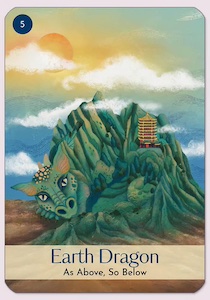
Iskandar offers a variety of oracle spreads, and I decided to start with the one card draw, which is called “One with the Tao.”4
“Taoism is about simplicity, and the simplest way to ask for guidance is to draw a card from the deck, especially when you’re seeking a quick answer, an insight into a specific matter, or an affirmation from your guides,” Iskandar says. “If a card jumps out before you pick one, it’s the Tao picking a card for you.”5
Turning the cards facedown to shuffle, I was dazzled by the beauty of the card backs, which depict the yin-yang dalliance of a phoenix and a dragon, the ultimate power couple in Feng Shui. They swirl in a galaxy of color, before a backdrop of stars. The phoenix has a rainbow of tail feathers with peacock eyes, while the dragon coils around her with sea green hair and a blur of pastel scales.
I didn’t have a specific question in mind, so I just asked for general guidance from the Tao. While I was shuffling, I saw a dragon’s head appear before my mind’s eye, signifying Yang energy. After I spent some time thoroughly shuffling the deck, the Tao flipped over a card for me: “Wood Horse: Live and Love Joyfully,” which depicts a horse galloping through a forest with sunlight streaming down through the canopy of branches and leaves.
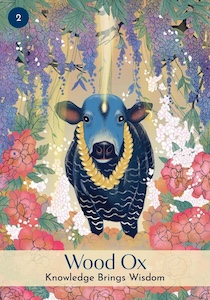
This energetic card carries the elemental energy of Yang Wood, symbolizing expansion and growth, and the Horse is a harbinger of “unbridled joy.”
“Heaven is there to guide you to a bright future, while Earth stands ready to bring you opportunities,”6 Iskandar says.
What a beautiful and reassuring message!
This versatile deck is a wonderful tool for exploring Chinese astrology, delving into natal charts, and seeking oracular wisdom from the Tao. For those eager to dive deeper into Chinese astrology beyond their year Pillar, Iskandar’s website offers a BaZi chart calculator to reveal your Four Pillars of Destiny and more.
The Chinese Five Elements Oracle is a treasure trove of wisdom and beauty. This is the first deck of its kind that I’ve seen, and it will be a valuable tool for both beginners and experienced practitioners of Chinese astrology.

Rachel Christina McConnell is a witch, tarot reader, intuitive astrologer, and writing spider. She holds an MFA in Fiction from Columbia University in the City of New York. Her short stories have appeared in Dark Moon Lilith Press and Minerva Rising Press’s The Keeping Room. Links to her publications are available here: https://rachelchristinamcconnell.wordpress.com
